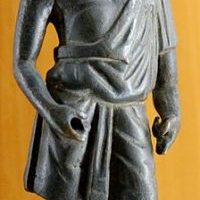Vulcan (Vulcanus), the god of Vulcanes, fire and blacksmithing. He was identified with Greek Hephaestus. Son of Jupiter and Juno. He was worshiped in the indoor campfire and in the temple on the Field of Mars. Blacksmith’s apprenticeship.
According to Marcus Terentius Varro, the cult of Vulcan was started with many others by Titus Tatius, who according to the Roman legend, was the king of the Sabines city of Cures, who after the kidnapping of women stood at the head of the army fighting against Rome.
During Vulcan holiday, Vulcanalia (Volcanalia), which took place at 23 August, fish and small animals (a calf or wild boar with a rusty ointment) were thrown into the fire. Legends also tell about the Vulcan being sacrificed by armor and weapons captured on the enemy during the war. He was always called during firefighting.
During Vulcanalia the Romans also hung their clothes and fabrics to the sun. Such a custom probably resulted from the theological relationship of Vulcan with the deified Sun.
It was believed that his forge was located under the crater of Mount Etna in Sicily, and the sounds coming from inside the Vulcan are the result of his work. He cast arrowheads and armor for Mars, Minerva and lightning for Jupiter. The Romans also believed that the Vulcan had its headquarters in the Solfatar crater1 in present-day Pozzuoli (near Naples), in Italy.
The oldest Vulcan sanctuary in Rome was Vulcanal, which was located at the foot of the Capitol on the Forum Romanum, and whose construction was believed to have been initiated by Tatius in the 8th century BCE.
The deity in the temple was looked after by flamen Volcanalis, one of the flamines minores.
Only once in history took place Ludi Volcanalici – in 20 BCE, during the reign of Octavian Augustus. In this way, they wanted to underline the importance of the signed treaty with the Parthians and the return of the legionary standards lost in the battle of Carrhae in 53 BCE.
When in 64 CE “Great Fire” broke out in Rome, a series of rites were held to appease Vulcan’s anger. The later emperor Domitian, under the influence of these events and subsequent fires, established a new altar dedicated to this god at Quirinal and ordered to sacrifice a red boar and a calf.








